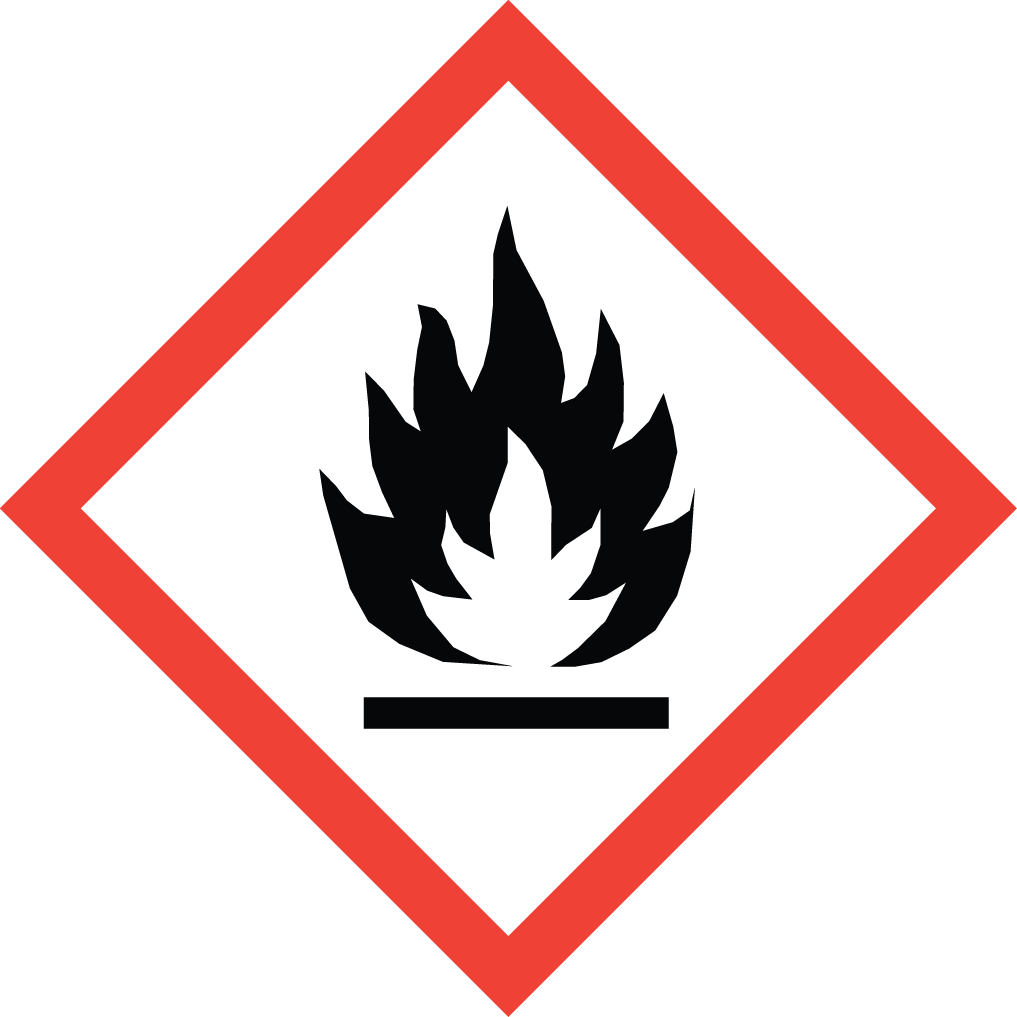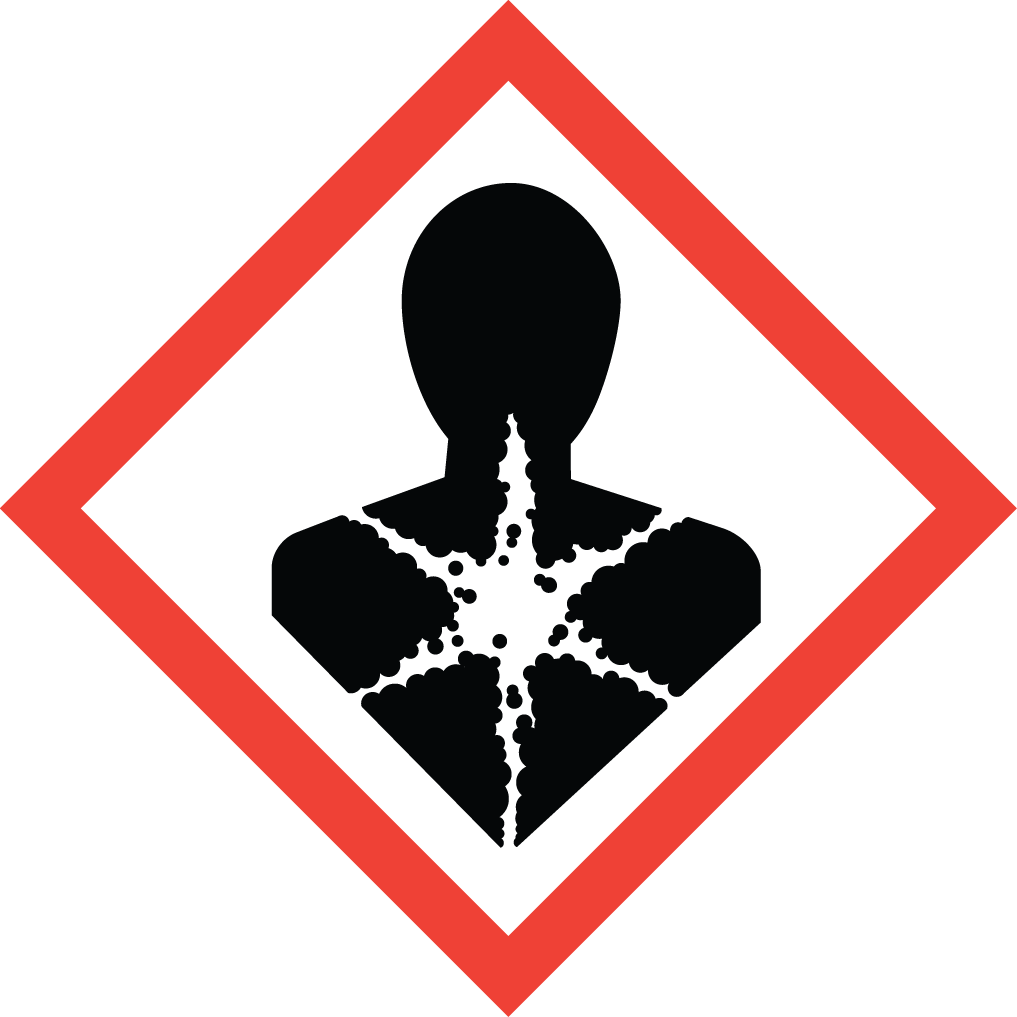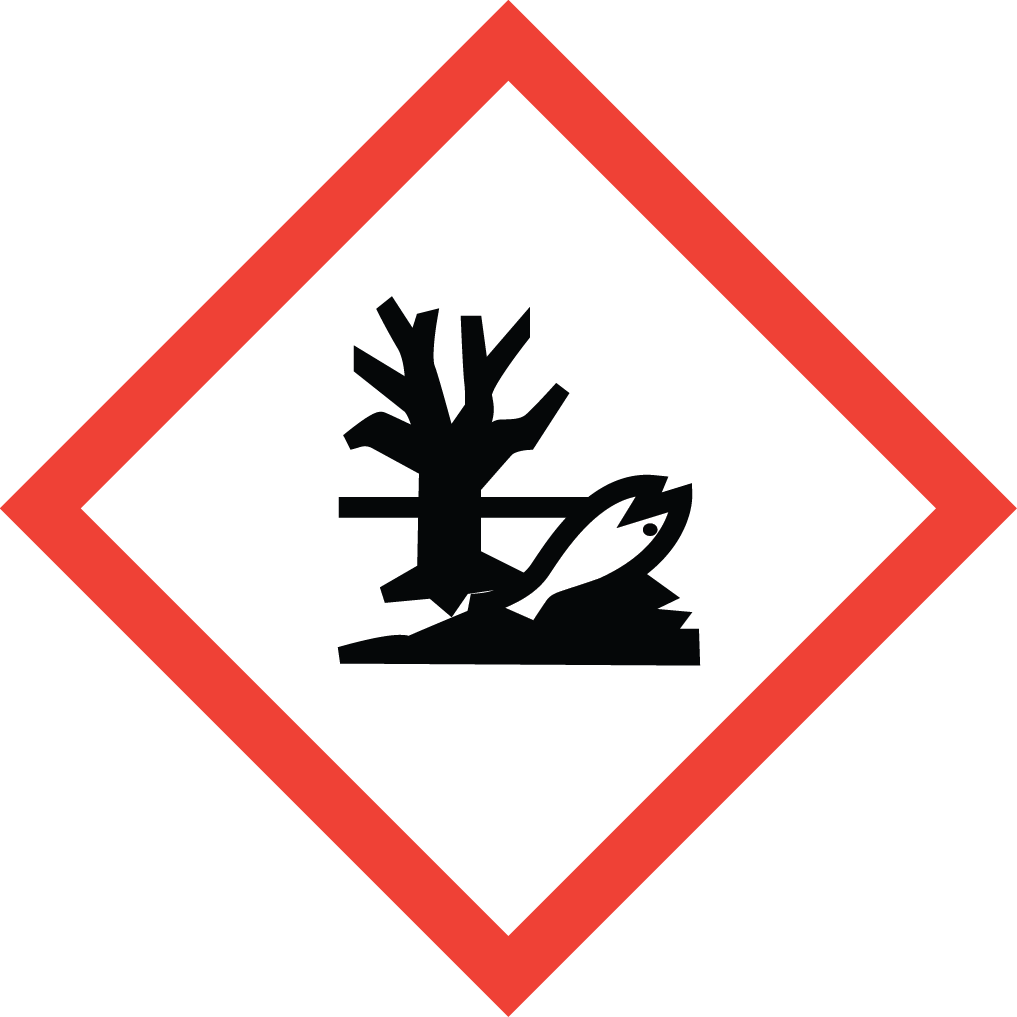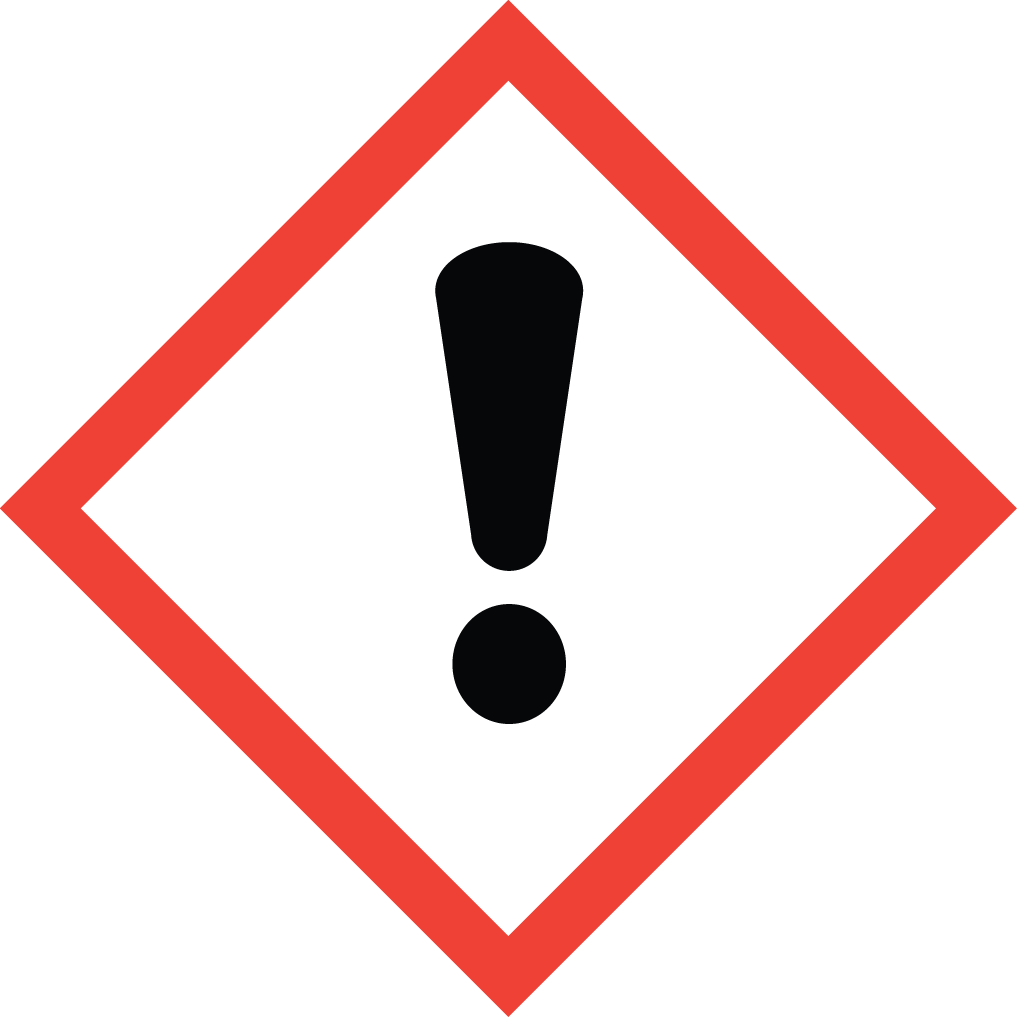Version 3.1
Date revised: 8/8/2023
SAFETY DATA SHEET
Conforms to regulation (EC) no. EU 453/2010
SECTION 1 - IDENTIFICATION OF THE SUBSTANCE/MIXTURE AND OF THE COMPANY/UNDERTAKING
1.1 Product Identifier
1.2 Relevant Identified Uses of the Substance/Mixture and Uses Advised Against
Investigational research by professional users
1.3 Details of the Supplier of the Safety Data Sheet
| Manufacturer National Diagnostics 305 Patton Drive Atlanta, GA 30036 (404) 699-2121 (800) 526-3867 info@nationaldiagnostics.com |
1.4 Emergency Telephone Number
ChemTel Inc.
Contract number MIS8894340
1-800 255-3924 (United States, Canada, Puerto Rico & US Virgin Islands)
01-800-099-0731 (Mexico)
400-120-0751 (China)
000-800-100-4086 (India)
1-300-954-583 (Australia)
0-800-591-6042 (Brazil)
+1-813-255-3924 (All other regions)
SECTION 2 - HAZARDS IDENTIFICATION
2.1 Classification of the Substance or Mixture
Classification according to Regulation (EC) No. 1272/2008 [EU-GHS/CLP]
H225 - Flammable Liquids (Category 2)
H302 - Acute Toxicity-Oral (Category 4)
H304 - Aspiration Hazard (Category 1)
H312 - Acute Toxicity-Dermal (Category 4)
H319 - Serious Eye Damage/Eye Irritation (Category 2A)
H332 - Acute Toxicity-Inhalation (Category 4)
H336 - May cause drowsiness or dizziness
H411 - Chronic Hazards to the Aquatic Environment (Category 2)
2.2 Label Elements
| GHS Label Elements | ||
 |  | DANGER H225 - Highly flammable liquid and vapor. |
 |  | |
2.3 Other Hazards
None found.
SECTION 3 - COMPOSITION/INFORMATION ON INGREDIENTS
3.2 Mixture
Chemical Names/Description
Aromatic hydrocarbons, cosolvents, and surfactants with scintillation phosphors
Component List
| Component | % Comp. | CAS # | EC # | 1278/2008 Classification |
|---|---|---|---|---|
| Solvent Naphtha, Light Aromatic | 50 - 60 | 64742-95-6 | 265-199-0 | H226, H304, H315, H336, H411 |
| Methanol | 5 - 10 | 67-56-1 | 200-659-6 | H225, H301, H311, H331, H371 |
| Alcohol ethoxylate phosphate ester | 20 - 30 | 51811-79-1 | H315, H319 |
SECTION 4 - FIRST AID MEASURES
4.1 Description of First Aid Measures
Inhalation
Remove to fresh air. If not breathing, give artificial respiration. If breathing is difficult, give oxygen. Call a physician.
Ingestion
Do not induce vomiting. If swallowed and the person is conscious, immediately give large amounts of water. Get medical attention.
Skin
Immediately flush skin with plenty of soap and water for at least 15 minutes while removing contaminated clothing and shoes. Get medical attention. Wash clothing before reuse. Thoroughly clean shoes before reuse.
Eyes
Immediately flush eyes with plenty of water for at least fifteen minutes, lifting lower and upper eyelids occasionally. Get medical attention immediately.
4.2 Most Important Symptoms and Effects, Both Acute and Delayed
Inhalation
Solvent Naphtha, Light Aromatic:
Symptoms may include sore throat, coughing, labored breathing, sneezing and burning sensation, depending on the concentration and duration of exposure. If CNS depression or effects occur, symptoms include headache, excitation, euphoria, dizziness, incoordination, drowsiness, light-headedness, blurred vision, fatigue, tremors, convulsions, loss of consciousness, coma, respiratory arrest and death, depending on the concentration and duration of exposure.
Methanol:
Irritation of the respiratory tract and mucous membranes. For central nervous system symptoms which may occur due to exposure by inhalation, see Ingestion.
Alcohol ethoxylate phosphate ester:
Discomfort in nose and throat, nasal discharge, coughing, difficulty breathing.
Ingestion
Solvent Naphtha, Light Aromatic:
Ingestion symptoms may include salivation, pain, nausea, vomiting, and diarrhea. Exposure may also cause central nervous system symptoms similar to those listed under Inhalation
Methanol:
Effects may include excitation, euphoria, headache, dizziness, drowsiness, blurred vision, fatigue, tremors, convulsions, loss of consciousness, coma, respiratory arrest and death.
Alcohol ethoxylate phosphate ester:
Abdominal discomfort, nausea, and diarrhea.
Skin
Solvent Naphtha, Light Aromatic:
Reddening, itching, and inflammation.
Methanol:
Exposure may cause symptoms similar to those listed under Ingestion.
Alcohol ethoxylate phosphate ester:
Local redness and swelling.
Eyes
Solvent Naphtha, Light Aromatic:
Irritation, redness, tearing, and blurred vision.
Methanol:
Irritation, redness, pain, and inflammation.
Alcohol ethoxylate phosphate ester:
Excess blinking and tear production. Marked redness and swelling of the eye with injury to the cornea.
4.3 Indication of Any Immediate Medical Attention and Special Treatment Needed
Unknown/not applicable
SECTION 5 - FIRE FIGHTING MEASURES
5.1 Extinguishing media
Dry powder, foam, carbon dioxide. (Water may be ineffective.)
5.2 Special Hazards Arising from the Substance/Mixture
Hazardous Combustion Products
Thermal decomposition products may include toxic oxides of nitrogen, and carbon.
Hazardous Decomposition Products
Combustion products include hazardous oxides or carbon, nitrogen, and sulfur.
Hazardous Polymerization
Will not occur under normal conditions of use (See Sections 10.4 & 10.5).
5.3 Advice for Firefighters
In the event of a fire, wear full protective clothing and NIOSH-approved self-contained breathing apparatus with full facepiece operated in the pressure demand or other positive pressure mode.
5.4 Further Information
No data available.
SECTION 6 - ACCIDENTAL RELEASE MEASURES
6.1 Personal Precautions
Wear appropriate protective equipment as specified in Section 8.
6.2 Environmental Precautions
Prevent discharge into the environment. Dike spills and stop leakage where practical. Do not allow material to enter drains.
6.3 Methods and Materials for Containment and Cleaning Up
Isolate hazard area and deny entry. Keep ignition sources out of area and shut off all ignition sources. Absorb spill with inert material (e.g. dry sand or earth) then place in a chemical waste container.
6.4 References to Other Sections
For disposal information see Section 13. For protective clothing and equipment see Section 8.
SECTION 7 - HANDLING AND STORAGE
7.1 Precautions for Safe Handling
Avoid contact and inhalation. Do not get in eyes, on skin, on clothing. Wash thoroughly after handling. Transfer methods should avoid static sparks. Use explosion proof ventilation.
7.2 Conditions for Safe Storage (including any incompatibles)
Keep in a tightly closed container, stored in a cooled, dry, ventilated area away from sources of heat or ignition. Protect from physical damage. Isolate from incompatible materials (section 10).
Incompatibles
Solvent Naphtha, Light Aromatic:
Oxidizing agents.
Methanol:
Acetyl bromide, calcium carbide, chlorine, chromic anhydride, cyanuric chloride, dichloromethane, diethyl zinc, lead perchlorate, magnesium, metals, strong oxidizers, perchloric acid, phosphorous trioxide, potassium, sodium hypochlorite, sulfuric acid and zinc.
Alcohol ethoxylate phosphate ester:
Oxidizing agents.
7.3 Specific End Uses
Investigational research by professional users
SECTION 8 - EXPOSURE CONTROLS/PERSONAL PRECAUTIONS
8.1 Control Parameters
Component: Solvent Naphtha, Light Aromatic
ACGIH Threshold Limit Value (TLV):
50 ppm
OSHA Permissable Exposure Limit (PEL):
None established
Component: Methanol
ACGIH Threshold Limit Value (TLV):
200 ppm
OSHA Permissable Exposure Limit (PEL):
None established
Component: Alcohol ethoxylate phosphate ester
ACGIH Threshold Limit Value (TLV):
none established
OSHA Permissable Exposure Limit (PEL):
None established
8.2 Exposure Controls
Engineering Controls
A system of local and/or general exhaust is recommended to keep employee exposures below the Airborne Exposure Limits. Local exhaust ventilation is generally preferred because it can control the emissions of the contaminant at its source.
Respiratory Protection
If the exposure limit is exceeded, wear a supplied air, full-facepiece respirator, airlined hood, or full-facepiece self-contained breathing apparatus.
Eye Protection
Use chemical safety goggles and/or a full face shield where splashing is possible. Maintain eye wash fountain and quick-drench facilities in work area.
Skin Protection
Wear impervious protective clothing, including boots, gloves, lab coat, apron or coveralls, as appropriate, to prevent skin contact.
SECTION 9 - PHYSICAL AND CHEMICAL PROPERTIES
9.1 Information on Basic Physical & Chemical Properties
| a. Appearance | Clear, colorless liquid | b. Odor | Slight aromatic |
| c. Odor Threshold | N.A. | d. pH | Neutral |
| e. Melting/Freezing Point (oC) | 0 | f. Boiling point (oC) | 182.2 |
| g. Flash Point (oC) | 23 | h. Evaporation Rate | < 0.1 Bu-Acetate = 1 |
| i. Flammability | Combustible | j. Upper/Lower Flammability or Explosive Limits | ND |
| k. Vapor Pressure | 2.0 mm Hg @ 25 C | l. Vapor Density (Air = 1) | 4.8 |
| m. Relative Density | 0.92 | n. Water Solubility | Gels w/ small quant. |
| o. Partition Coefficient n-octanol/water | Mixture | p. Autoignition Temperature (oC) | 865.4 F |
| q. Decomposition Temperature (oC) | Not applicable. | r. Viscosity | 5.5 cSt @ 23 C |
| s. Explosive Properties | N.A. | t. Oxidizing Properties | Not an oxidizer |
SECTION 10 - STABILITY AND REACTIVITY
10.1 Reactivity
Not reactive under recommended conditions of use.
10.2 Chemical Stability
Stable under normal conditions of use.
10.3 Possibility of Hazardous Reactions
Will not occur under normal conditions of use (See Sections 10.4 & 10.5).
10.4 Conditions to Avoid
Heat, sources or ignition, and incompatibles.
10.5 Incompatible Materials
Solvent Naphtha, Light Aromatic:
Oxidizing agents.
Methanol:
Acetyl bromide, calcium carbide, chlorine, chromic anhydride, cyanuric chloride, dichloromethane, diethyl zinc, lead perchlorate, magnesium, metals, strong oxidizers, perchloric acid, phosphorous trioxide, potassium, sodium hypochlorite, sulfuric acid and zinc.
Alcohol ethoxylate phosphate ester:
Oxidizing agents.
10.6 Hazardous Decomposition Products
Combustion products include hazardous oxides or carbon, nitrogen, and sulfur.
SECTION 11 - TOXICOLOGICAL INFORMATION
Product LD50 Values
Oral Rat LD50 (mg/kg)
No Data
Dermal Rabbit LD50 (mg/kg)
No Data
Component Cancer List Status
| NTP Carcinogen | |||
| Known | Anticipated | IARC Category | |
|---|---|---|---|
| Solvent Naphtha, Light Aromatic | No | No | 3 |
| Methanol | No | No | None |
| Alcohol ethoxylate phosphate ester | No | No | None |
Potential Health Effects
Inhalation
Solvent Naphtha, Light Aromatic
SLIGHTLY TOXIC. Breathing of the mists, vapors or fumes may irritate the nose, throat, and lungs. May cause central nervous system depression or effects. May cause cardiac sensitization, including arrhythmias (irregular heart beats) and death due to cardiac arrest. Chronic exposure to high doses may damage the peripheral nerves, resulting in numbness or tingling in the extremities. See also Reproductive Toxicity and Target Organ Statement for further special toxic effects.
Methanol
May irritate the respiratory tract and mucuous membranes. Exposure may cause central nervous system symptoms similar to those listed under Ingestion.
Alcohol ethoxylate phosphate ester
Vapors or mist, expecially as generated from heating the material or as from exposure in poorly ventilated areas or confined spaces, may be irritating and cause discomfort in nose and throat. Prolonged exposure may cause difficulty breathing.
Ingestion
Solvent Naphtha, Light Aromatic
MODERATELY TOXIC. May cause irritation of the mouth, throat, and gastrointestinal tract. Aspiration into lungs may cause chemical pneumonia and lung damage. Aspiration symptoms may be delayed in onset by up to 24 hours. Exposure may also cause central nervous system symptoms similar to those listed under Signs and Symptoms of Overexposure - Inhalation. See also Reproductive Toxicity and Target Organ Statement for further special toxic effects.
Methanol
Primary toxic effects are metabolic acidosis and visual system damage. Visual system damage may progress from visual blurring to complete blindness. May cause harmful central nervous system effects which may be delayed.
Alcohol ethoxylate phosphate ester
May be harmful by ingestion.
Skin
Solvent Naphtha, Light Aromatic
SLIGHTLY IRRITATING. Contact may cause reddening, itching and inflammation. Repeated or prolonged skin contact may cause reddening, itching and inflammation. Defatting agent.
Methanol
Absorption from prolonged or massive skin contact may cause poisoning. Repeated or prolonged contact may result in defatting, redness, itching, inflammation, cracking and possible secondary infection. Exposure may cause symptoms similar to those listed under ingestion.
Alcohol ethoxylate phosphate ester
Brief contact may cause slight irritation. Prolonged contact, as with clothing wetted with material, may cause more severe irritation and discomfort.
Eyes
Solvent Naphtha, Light Aromatic
SLIGHTLY IRRITATING. Exposure to vapors, fumes or mists may cause irritation. Direct contact may cause irritation, redness, tearing, and blurred vision. Prolonged or repeated exposure may cause irritation and conjunctivitis.
Methanol
Exposure to liquid, vapors, fumes or mists may cause irritation. Direct contact may cause irritation, pain, corneal inflammation and possible corneal damage.
Alcohol ethoxylate phosphate ester
Causes irritation and possible injury to the cornea.
Carcinogenicity
Solvent Naphtha, Light Aromatic
Benzene, a known carcinogen, may be present in trace amounts, less than 50 ppm. Otherwise, there are no known or anticipated carcinogens present in Naphtha.
Methanol
This component is not listed as a carcinogen by NTP or IARC.
Alcohol ethoxylate phosphate ester
Not listed by NTP or IARC as a known or possible carcinogen.
Mutagenicity
Solvent Naphtha, Light Aromatic
No information available.
Methanol
No information available.
Alcohol ethoxylate phosphate ester
No information available.
Reproductive Toxicity
Solvent Naphtha, Light Aromatic
This product contains components which may cause adverse reproductive effects. Pregnant women may be at an increased risk from exposure. Consumption of alcoholic beverages may enhance toxic effects.
Methanol
Possible reproductive hazard.
Alcohol ethoxylate phosphate ester
No information available.
Teratogenic Effects
Solvent Naphtha, Light Aromatic
This product contains components which may cause adverse developmental effects. Pregnant women may be at an increased risk from exposure. Consumption of alcoholic beverages may enhance toxic effects.
Methanol
No information available.
Alcohol ethoxylate phosphate ester
No information available.
Routes of Entry
Solvent Naphtha, Light Aromatic
Inhalation, ingestion, or skin contact.
Methanol
Inhalation, ingestion, or skin contact.
Alcohol ethoxylate phosphate ester
Ingestion, inhalation.
Target Organ Statement
Solvent Naphtha, Light Aromatic
Acute or chronic overexposure to this material or its components may cause systemic toxicity, including adverse effects to the following: kidney, liver, spleen, adrenals, thymus and central nervous system. Pre-existing medical conditions which may be aggravated by exposure include disorders of the skin, kidney, liver, cardiovascular and respiratory systems.
Methanol
Chronic intoxication may cause degenerative changes in liver, kidneys, brain, gastrointestinal tract, and heart muscle. Persons with pre-existing liver impairment, skin and respiratory disorders may be at an increased risk from exposure.
Alcohol ethoxylate phosphate ester
No information available.
SECTION 12 - ECOLOGICAL INFOMATION
12.1 Toxicity
COMPONENT: Solvent Naphtha, Light Aromatic
| Vertebrates | Invertebrates | Algae | Microorganisms | |
|---|---|---|---|---|
Aquatic Toxicity (ppm unless otherwise noted) | LL50 (96 hr, fathead minnow) 8.2mg/l | EL50 (48hr, daphnia) 4.5mg/l | EL50 3.1mg/l | EL50 15mg/l |
| Birds | Arthropods | Plants | Microorganisms | |
|---|---|---|---|---|
Terrestrial Environment Toxicity (ppm unless otherwise noted) | No data | PNEC 0.4-20 mg/l | PNEC 0.4-20 mg/l | PNEC 0.4-20 mg/l |
COMPONENT: Methanol
| Vertebrates | Invertebrates | Algae | Microorganisms | |
|---|---|---|---|---|
Aquatic Toxicity (ppm unless otherwise noted) | LC50 (96hr, bluegill) 15400 mg/L | EC50 (48 hr, daphnia) > 10000 mg/L | EC50 (96 hr) 22000 mg/L | IC50 (3hr) > 1000 mg/L |
| Birds | Arthropods | Plants | Microorganisms | |
|---|---|---|---|---|
Terrestrial Environment Toxicity (ppm unless otherwise noted) | IC50 (3 day, sativa) 41000 mg/L | No data | No data | No data |
COMPONENT: Alcohol ethoxylate phosphate ester
| Vertebrates | Invertebrates | Algae | Microorganisms | |
|---|---|---|---|---|
Aquatic Toxicity (ppm unless otherwise noted) | No data | No data | No data | No data |
| Birds | Arthropods | Plants | Microorganisms | |
|---|---|---|---|---|
Terrestrial Environment Toxicity (ppm unless otherwise noted) | No data | No data | No data | No data |
12.2 Persistence and Degradability
Solvent Naphtha, Light Aromatic
Inherently biodegradable: 74% elimination in 28 days
Methanol
Readily biodegradable (95% elimination in 20 days)
Alcohol ethoxylate phosphate ester
Not readily biodegradable- 13% elimination in 28 days
12.3 Bioaccumulative Potential
Solvent Naphtha, Light Aromatic
No data
Methanol
BCF<10
Alcohol ethoxylate phosphate ester
No data
12.4 Mobility in Soil
Solvent Naphtha, Light Aromatic
log Koc ~2
Methanol
Koc <1
Alcohol ethoxylate phosphate ester
Ultimate destination: water or sediment
12.5 Results of PBT and vPvB Assessment
Solvent Naphtha, Light Aromatic
not PBT / vPvB
Methanol
not PBT or vPvB
Alcohol ethoxylate phosphate ester
No data
12.6 Other Adverse Effects
Solvent Naphtha, Light Aromatic
None
Methanol
None
Alcohol ethoxylate phosphate ester
None
SECTION 13 - DISPOSAL CONSIDERATIONS
13.1 Waste Treatment Methods
Offer surplus or non-recyclable product to licensed disposal company. Disposal is subject to user compliance with applicable law and product characteristics at time of disposal. Dispose of packaging as product.
SECTION 14 - TRANSPORT INFORMATION
| ADR/RID | IATA | IMO | DOT | |
|---|---|---|---|---|
| 14.1 UN Number | 1268 | 1268 | 1268 | 1268 |
| 14.2 Shipping Name | Petroleum Products N.O.S. | Petroleum Products N.O.S. | Petroleum Products N.O.S. | Petroleum Products N.O.S. |
| 14.3 Hazard Class | 3 | 3 | 3 | 3 |
| 14.4 Packing Group | III | III | III | III |
| 14.5 Environmental Hazards | N.A. | N.A. | Not regulated | N.A. |
| 14.6 Special Precautions | N.A. | N.A. | N.A. | N.A. |
SECTION 15 - REGULATORY INFORMATION
15.1 Safety, Health and Environmental Regulations/Legislation Specific for the Substance/Mixture
United States
TSCA Regulatory Statement
All intentional ingredients are listed on the TSCA Inventory.
SARA 311/312 Hazard Categories
| Component | Fire | Pressure | Reactivity | Acute | Chronic |
|---|---|---|---|---|---|
| Solvent Naphtha, Light Aromatic | Yes | No | No | Yes | Yes |
| Methanol | Yes | No | No | Yes | Yes |
| Alcohol ethoxylate phosphate ester | No | No | No | Yes | No |
Europe
EEC Regulatory
All intentional ingredients are listed on the European EINECS Inventory.
SECTION 16 - OTHER INFORMATION
Revisional Updates
8/8/2023 - Updated Section 14.5
4/26/2019 - Updated Section 1.4
5/29/2015 - Updated Sections 2.1 and 3.1
8/12/2013 - Released Version 1.0
NFPA Codes
Health 1 Flammability 3 Reactivity 0
Dangers
Solvent Naphtha, Light Aromatic
H226 - Flammable liquid and vapor.
H304 - May be fatal if swallowed and enters airways.
H315 - Causes skin irritation.
H336 - May cause drowsiness or dizziness.
H411 - Toxic to aquatic life with long lasting effects.
Methanol
H225 - Highly flammable liquid and vapor.
H301 - Toxic if swallowed
H311 - Toxic in contact with skin.
H331 - Toxic if inhaled.
H371 - May cause damage to organs.
Alcohol ethoxylate phosphate ester
H315 - Causes skin irritation.
H319 - Causes serious eye irritation.
MANUFACTURER DISCLAIMER: The information given herein is offered in good faith as accurate, but without guarantee. Conditions of the use and suitability of the product for particular uses are beyond our control. All risks of use of the product are therefore assumed by the user. Nothing is intended as a recommendation for uses which infringe valid patents or as extending license under valid patents. Appropriate warnings and safe handling procedures should be provided to handlers and users.